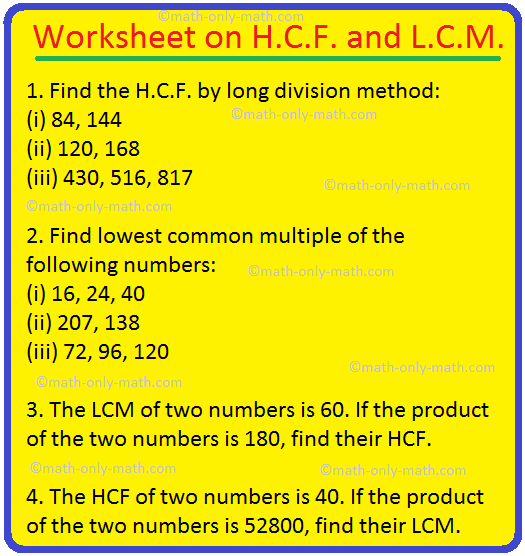Subscribe to our ▶️ YouTube channel 🔴 for the latest videos, updates, and tips.
Worksheet on H.C.F. and L.C.M.
We will solve different types of problems given in the Worksheet on H.C.F. and L.C.M.
I. Fill in the blanks:
(i) The HCF of two numbers is 1, they are called ……………. numbers.
(ii) The LCM of two or more numbers cannot be ……………. than any one of the numbers.
(iii) The HCF of the given numbers cannot be ……………. than the number themselves.
(iv) The HCF of 7 and 35 is …………….
(v) The LCM of 7 and 35 is …………….
II. Find highest common factor of the following by complete factorisation:
(i) 48, 56, 72
(ii) 198, 360
(iii) 102, 68, 136
(iv) 1024, 576
(v) 405, 783, 513
III. Find the H.C.F. by long division method:
(i) 84, 144
(ii) 120, 168
(iii) 430, 516, 817
(iv) 632, 790, 869
(v) 291, 582, 776
(vi) 219, 1321, 2320, 8526
IV. Find lowest common multiple of the following numbers:
(i) 16, 24, 40
(ii) 40, 56, 60
(iii) 207, 138
(iv) 72, 96, 120
(v) 120, 150, 135
(vi) 102, 170, 136
V. The LCM of two numbers is 60. If the product of the two numbers is 180, find their HCF.
VI. The HCF of two numbers is 40. If the product of the two numbers is 52800, find their LCM.
VII. The HCF and LCM of two numbers is 5 and 30 respectively. If one of the numbers is 10, find the other number.
Note: LCM × HCF = Product of numbers
Answers for the highest common factor (H.C.F.) and lowest common multiple (L.C.M.) are given below.
Answers:
I. (i) Co-prime
(ii) less
(iii) greater
(iv) 7
(v) 35
II. (i) 8
(ii) 18
(iii) 34
(iv) 64
(v) 27
III. (i) 12
(ii) 24
(iii) 43
(iv) 79
(v) 97
(vi) 1
IV. (i) 240
(ii) 840
(iii) 414
(iv) 1440
(v) 5400
(vi) 2040
V. 3
VI. 1320
VII. 15
Common Multiples.
Least Common Multiple (L.C.M).
To find Least Common Multiple by using Prime Factorization Method.
Examples to find Least Common Multiple by using Prime Factorization Method.
To Find Lowest Common Multiple by using Division Method
Examples to find Least Common Multiple of two numbers by using Division Method
Examples to find Least Common Multiple of three numbers by using Division Method
Relationship between H.C.F. and L.C.M.
Worksheet on H.C.F. and L.C.M.
Word problems on H.C.F. and L.C.M.
Worksheet on word problems on H.C.F. and L.C.M.
5th Grade Math Problems
From Worksheet on H.C.F. and L.C.M. to HOME PAGE
Didn't find what you were looking for? Or want to know more information about Math Only Math. Use this Google Search to find what you need.



New! Comments
Have your say about what you just read! Leave me a comment in the box below. Ask a Question or Answer a Question.